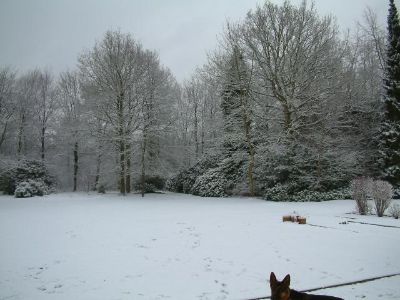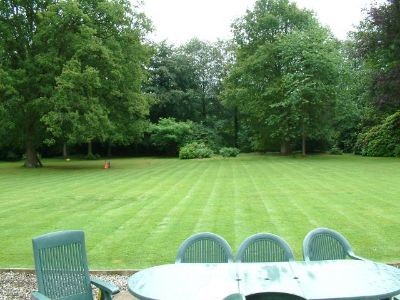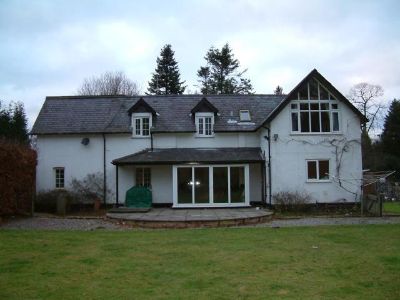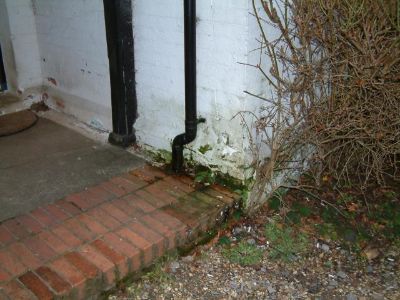| 
The area around Longmoor Lodge has a geological strata known as the Bagshot Beds. This provided the material for iron smelting - there is evidence of this taking place in medieval times, but according to Reading Museum may have taken place on this site s early as the Roman period. tt is a matter of speculation though whether there was any actual settlement here.
Here however is a more recent and accurate history kindly provided by Mr Richard Sale, a previous owner of Longmoor Lodge.
The original Lodge was built between 1860 and 1870 to serve as a keeper’s cottage for the Bearwood Estate which was owned by the Walter family who founded The Times newspaper. Bearwood House is a massive neo-gothic pile that is now a private school and is about 2 miles from Longmoor Lodge. The original Bearwood estate was in the order of 11,000 acres and stretched from Bearwood House to Sandhurst enveloping this area and a number of other settlements.
Following the death of John Walter III in 1926 the estate was broken up and sold off in small parcels to different buyers. Longmoor Lodge and the surrounding land was sold to a Mr & Mrs White - they were keen gardeners and built a tiny cottage close to Longmoor Lodge for their gardener, Longmoor Cottage has grown considerably since then and is now home to our neighbours. The Whites also excavated series of drains and ponds across the land, some of which have become overgrown and swampy – we almost lost a dumper in one of these!
After Mr White’s death in 1943 the Sale family acquired Longmoor Lodge and the surrounding land. At that time, the house was little changed from its original state. There was a kitchen, dining room and sitting room downstairs plus a small cloakroom and toilet. Upstairs were two bedrooms and a bathroom. There were no mains services at that point and water was drawn from a well below the house. Within few years water and gas arrived but not until 1956 did mains electricity get to Longmoor Lodge.
The first extensions were added to the house in 1947 with others in the 1950s. The Sales were keen gardeners and Mr Sale, a local nurseryman was responsible for the wonderful planting of trees and shrubs that we still enjoy today. Following Mr Sale’s illness in 1973, his son Richard took on the house and enjoyed many years as their six children grew up. This is a truly wonderful place for kids to enjoy with the woods and lawns. The Sales kept horses here are we use the stables as storage and hope one day to bring horses back.
The Sales sold Longmoor Lodge in the early nineties and we were lucky enough to acquire it in 1999. As I mention below, the house did suffer some neglect in the years between the Sale’s departure and our arrival and had become uneconomic to renovate. I am delighted though that Mr Sale has given his blessing to what we are doing here. The gardens and land will remain almost as they were when the Sales left and this was what originally attracted us to Longmoor Lodge.
 We purchased Longmoor Lodge in the Spring of 1999. The house lays between the villages of Arborfield, Barkham and Finchamstead about 8 miles from Reading and 4 miles from Wokingham. We purchased Longmoor Lodge in the Spring of 1999. The house lays between the villages of Arborfield, Barkham and Finchamstead about 8 miles from Reading and 4 miles from Wokingham.
The house has a 70m driveway and sits in a lovely mature garden surrounded by woodland. When we purchased the house it had about 3 acres of land but soon after I was able to purchase a further 8 acres of land that surround the house.
Apart from a large grassed area at the rear and side of the house, most of the land is wooded. There are a number of specimen trees and shrubs including a row of 6 maples, a huge cedar, a 200 year oak and an even older oak deep in the woodland at the back. There are two areas of rhododendrons and azaleas that have been astutely planted (probably 30 years ago or more) that flower in the most breathtaking combinations of colour during late April and May.
 The area on the eastern boundary has been designated a Site of Special Scientific Interest, as it is apparently an 8,000 year old bog land that supports many rare species. However, the tenacity of the rhododendrons is very obvious even in there judging by the amount of non-native purple flowers you see in spring and the mangrove-like roots. The area on the eastern boundary has been designated a Site of Special Scientific Interest, as it is apparently an 8,000 year old bog land that supports many rare species. However, the tenacity of the rhododendrons is very obvious even in there judging by the amount of non-native purple flowers you see in spring and the mangrove-like roots.
Wildlife is abundant on the land; we have red and muntjack deer, badgers, pheasant, woodpeckers, all the usual garden and woodland birds, foxes, hedgehogs and the ubiquitous rabbit. Frankly we are overrun with rabbits at times and we have had to take measures in the past to control the local population as their ground works undermine some of the larger trees.
Longmoor Lodge started from very humble beginnings, built in brick with a blue slate tiled roof, it was very much in the local vernacular of 150 years ago. However, according to the various documentation we got with the house, it looks like it has been extended 5 times, most recently in 1984. It is now a 6 bedroom, rambling rather ramshackle place of dubious build quality and no architectural merit.
 Crucially the last extension which was the largest, is of very poor construction quality, and shows the kind of faults you would expect in the jerry-built mass housing of years gone by. Also, very little maintenance to the fabric of the house has been done by the pervious owners, which meant we brought the place in pretty poor condition expecting to invest significant time and money in renovation. Crucially the last extension which was the largest, is of very poor construction quality, and shows the kind of faults you would expect in the jerry-built mass housing of years gone by. Also, very little maintenance to the fabric of the house has been done by the pervious owners, which meant we brought the place in pretty poor condition expecting to invest significant time and money in renovation.
 This is supposed to be a soak-away. It does not soak anywhere so water builds up in the stand-pipe and seeps into the brickwork causing damp in the dining room. This is supposed to be a soak-away. It does not soak anywhere so water builds up in the stand-pipe and seeps into the brickwork causing damp in the dining room.
 You can see where the orginal roof joins the extension, not only are they at different levels, the builder didn't even bother to match the ridge tiles. You can see where the orginal roof joins the extension, not only are they at different levels, the builder didn't even bother to match the ridge tiles.
| |


